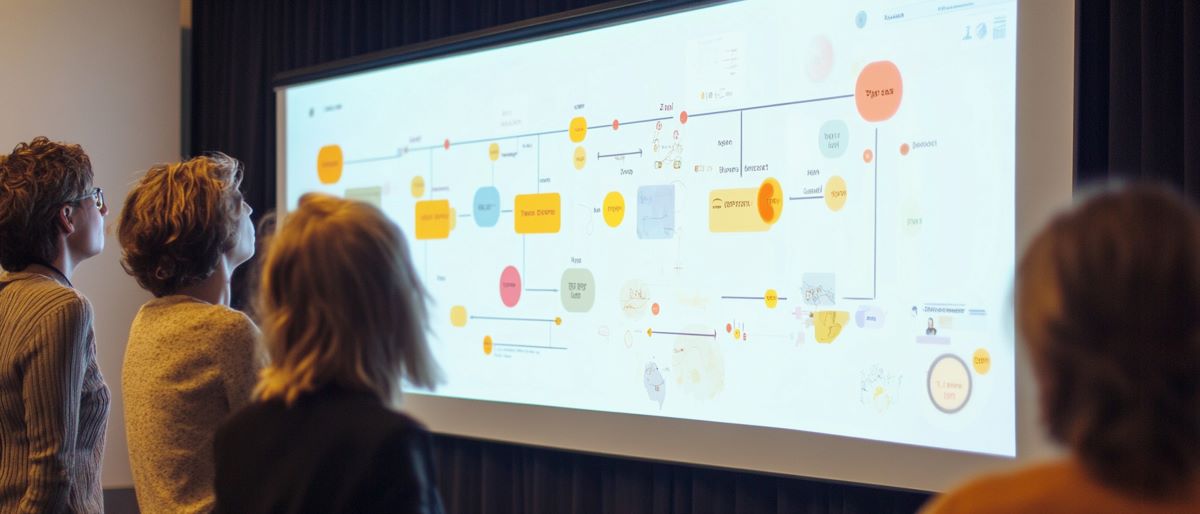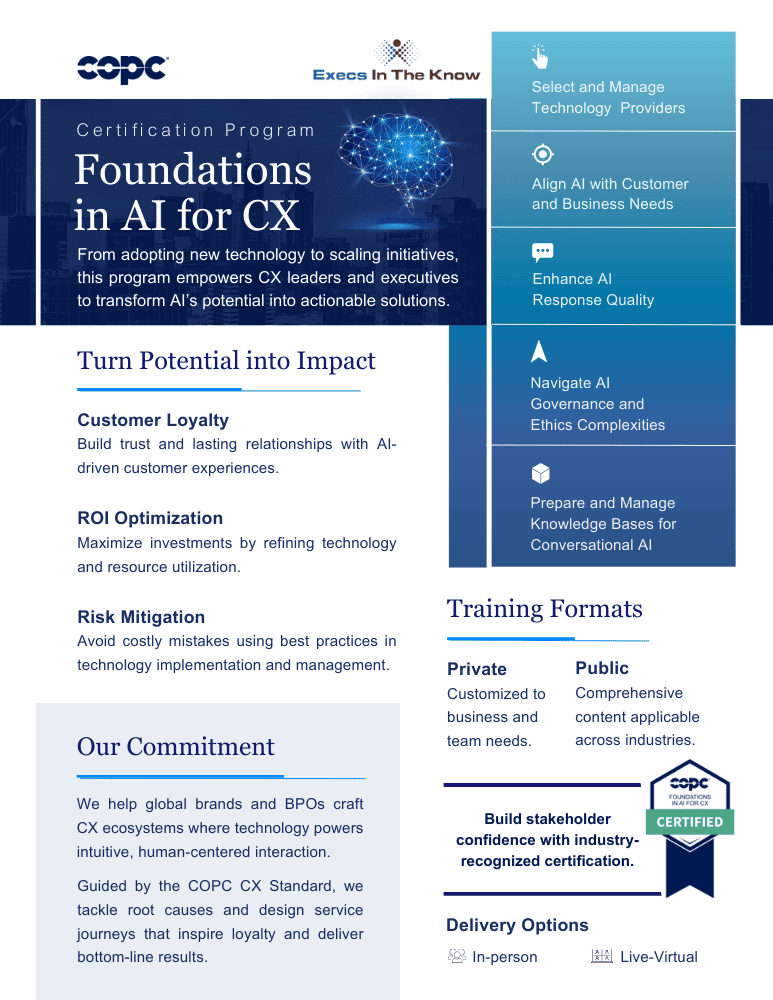
May 15, 2025
Organizations that master proactive journey design fundamentally change the competitive landscape by solving problems customers don’t yet know they have.
This article distills key insights from The AI Divide, a COPC webinar featuring CX leaders from Wayfair, Broad River Retail, and more. From predictive journey design to the changing role of frontline agents, the conversation made one thing clear: the future of CX is increasingly proactive.
In customer experience, faster isn’t always better.
Most organizations have spent decades perfecting the art of reactive service, reducing handle times, optimizing resolutions, and improving first-contact fixes. But today’s best CX leaders are quietly building an advantage that’s harder to see — and much harder to copy.
They’re eliminating the need for support altogether.
What is Proactive Customer Journey Optimization?
Proactive customer journey optimization is a strategic approach that anticipates and eliminates potential friction points before customers encounter them. Unlike reactive support models that respond to problems after they occur, proactive journey design uses predictive analytics, behavioral patterns, and cross-channel orchestration to prevent issues from arising in the first place.

This approach transforms the customer experience from problem resolution to problem prevention, creating seamless experiences while reducing operational costs. Proactive customer journeys, not reactive service, are reshaping the future of customer support. The companies mastering them create silent loyalty engines that competitors can’t easily mimic.
Reactive Support Isn’t Enough Anymore
Traditional CX models are built to fix problems, not prevent them. Even when organizations resolve issues quickly, the customer still experiences friction: they notice a problem, reach out, and ask for help.
Today’s customers value effortlessness more than recovery. They expect brands to anticipate their needs and eliminate pain points before they surface. Organizations that stay reactive — even efficient — risk losing loyalty to those who remain invisible.
“We have seen a lot of transformation in this space, and technology has played a big role from being reactive in solving customers’ problems… to being more proactive and personalized so that you can solve the problem even before the customer tells you there’s a problem.” —Shantanu Das, Wayfair
What Proactive CX Looks Like
Proactive CX eliminates the need for response through purposeful journey design—and isn’t one-size-fits-all. Different customer segments have different channel preferences and expectations.
During The AI Divide webinar, industry experts note that while ride-sharing customers may want everything in an app with minimal human contact, banking customers might prefer speaking with a representative for complex and sensitive financial matters. Effective proactive journey design respects these differences rather than forcing all customers into the same digital-first template.
Proactive organizations:
- Map the customer journey to identify and eliminate friction points
- Predict customer needs based on behavioral patterns, not past complaints
- Use AI and automation strategically — not to deflect contact, but to prevent it
- Build systems where customers experience seamless outcomes without ever filing a ticket or making a call
This kind of invisible service experience is no accident. It’s intentional, upstream design.
“There’s a fine line between pushing the problem onto the customer and pushing the solution to them. The best experiences feel invisible.” —Jeff Tropeano, COPC Inc.
The Strategic Shift: From Contact Resolution to Contact Prevention
In traditional models, we measure success by how quickly and efficiently a team resolves an issue.
Whereas in journey-first models, success is measured by how few issues arise in the first place.
| Reactive Customer Service | Proactive Customer Experience |
| Solves problems after they occur | Prevents problems before they happen |
| Measures speed of resolution | Measures absence of issues |
| Focuses on service efficiency | Focuses on journey design |
| Treats symptoms | Addresses root causes |
Leading organizations are shifting their metrics:
- From handle time ➔ to effort elimination
- From satisfaction after service ➔ to silent, seamless journeys
- From cost-per-contact ➔ to value-per-absence-of-contact
Proactive journey design is better for business: higher loyalty, lower operational costs, stronger brand trust. However, organizations often underinvest in preventing customer issues while overinvesting in technology for problems that have already occurred. Shifting budget priorities toward proactive issue identification and resolution represents a fundamental change in CX strategy.
Proactive CX Implementation: A Crawl-Walk-Run Approach
Moving to proactive journeys is a phased, strategic shift requiring patience, organizational alignment, and disciplined execution. The most successful organizations follow a measured Crawl-Walk-Run approach that builds capabilities systematically while delivering incremental value.
Phase 1: Customer Journey Friction Prevention: Strategy, Documentation and Design
Lay the groundwork through internal alignment, focusing on understanding customer journeys and addressing the most obvious preventable issues.
Key Efforts:
- Facilitate whiteboarding sessions across CX, Ops, and Tech to align on goals, metrics, and success criteria.
- Map current-state journeys, focusing on high-volume, high-friction interactions across customer and operational layers.
- Analyze top contact drivers to identify opportunities for proactive communication or process redesign.
- Document gaps in ownership, governance, and data visibility across the journey.
- Define and socialize journey-first design principles to guide future orchestration.
- Deploy basic notification systems for common, repetitive contact types (e.g., order confirmations, shipping updates, appointment reminders).
Quick Win Example: One retailer discovered that a disproportionate amount of support contacts came from customers checking order status. Implementing proactive shipment notifications with tracking information reduced these contacts within 60 days while improving customer satisfaction scores for the ordering journey.
Measurement Focus: Track the reduction in specific contact types and calculate the direct ROI by multiplying the contacts prevented by your average cost-per-contact.
“Investment in prevention of customer issues and solving them proactively is often overlooked in favor of technology for when problems have already happened,” notes Shantanu Das of Wayfair. Organizations that shift even 15-20% of their service budget from resolution to prevention typically see immediate returns.
Phase 2: Proactive Execution — Automation, Analytics, and Early Intervention
Build on strategic foundations by addressing high-frequency friction points with lightweight automation and predictive insights. Focus on simple, measurable interventions that reduce preventable contacts and customer effort.
Key Efforts:
- Use journey analytics or contact reason coding to identify the most frequent and repetitive support requests.
- Prioritize low-complexity, high-volume interactions (e.g., “Where is my order?”, password resets, billing inquiries) for intervention.
- Deploy front-end automation to eliminate or streamline recurring tasks (e.g., dynamic FAQs, proactive SMS/email updates, status portals).
- Establish early warning systems to detect emerging friction patterns (e.g., delayed shipments, incomplete applications, stalled onboarding).
- Introduce behavior-based triggers that initiate outreach when customers deviate from expected patterns or encounter likely confusion.
- Begin tracking “silent success” metrics—journeys completed without support—as a leading indicator of CX improvement.
Impact Example: A telecommunications provider implemented journey analytics to identify customers likely to experience service disruptions due to network maintenance. By proactively communicating with these customers and providing alternatives, they reduced support calls during maintenance periods and improved retention metrics.
Measurement Focus: Start tracking “silent success rate” – the percentage of customers who complete journeys without support – and journey completion rates across segments.
“We’re moving away from those days of building out five million intents and mapping out questions. Instead, we’re taking our knowledge base and letting the system do all the natural language processing to anticipate needs.” —Shantanu Das of Wayfair
Phase 3: Scale Proactive Customer Experience Across the Ecosystem
Advance from tactical fixes to end-to-end journey orchestration powered by data, automation, and AI. At this stage, proactive design becomes embedded across your CX ecosystem—transforming how your organization anticipates, prevents, and personalizes customer experiences.
Key Efforts:
- Deploy AI models to predict journey friction before it occurs, enabling dynamic interventions across channels.
- Build closed-loop learning systems where customer behavior, outcome data, and feedback continuously improve orchestration logic.
- Expand cross-channel journey orchestration to ensure consistency and personalization regardless of entry point (e.g., email → chat → voice).
- Align teams to journey-based ownership structures, replacing siloed channel or department KPIs with shared journey outcomes.
- Implement customer health scoring and friction indices to flag journeys requiring proactive support or redesign.
- Develop and monitor “prevention value” metrics—quantifying the business impact of issues never escalated.
“The customer may choose to self-serve, the customer may choose to have the bot lead them where they need to, but it’s keeping that humanized approach to where you can get a human quickly if needed.” —Wes Dudley of Broad River Retail
Transformation Example: A financial services firm restructured its organization around customer journeys rather than channels, creating dedicated teams responsible for end-to-end experiences. This shift enabled them to reduce effort scores while simultaneously decreasing operational costs by implementing preventative measures at critical journey points.
Measurement Evolution: At this stage, organizations typically develop sophisticated “prevention value” metrics that quantify the direct cost savings and the loyalty impact of proactive interventions.

Build the Skills to Lead Proactive CX
If your team is ready to move from reactive firefighting to proactive, journey-first design, the Foundations in AI for CX course can help you build the right capabilities. Learn how to align tech, talent, and processes to prevent problems before they arise.
Essential Success Factors for Future-Ready Customer Service
Regardless of your current maturity, these principles are central to successful implementation:
- Executive sponsorship that recognizes prevention as a strategic investment, not a cost center
- Cross-functional alignment around journey metrics rather than departmental KPIs
- Agile implementation methodology following the “try fast, fail fast, learn fast, pivot fast” approach
- Balanced technology and process focus, ensuring that tools enable rather than drive strategy
Technology and customer expectations are changing so rapidly that waiting for perfect solutions puts organizations at a disadvantage. The most successful companies implement small, measurable, proactive initiatives, learn from the results, and scale what works.
As technology evolves, the more complex problems will still need human intervention, requiring what Shantu Das of Wayfair terms “genius agents”. Proactive journey design enhances the human element by allowing skilled agents to focus on complex, high-value interactions while preventing routine issues entirely.
Collen Beers emphasizes how detrimental change management is during this transformation. Without proper communication with frontline agents and customers, even the most innovative, proactive solutions may fail to deliver their full potential. Bringing teams along on the journey through transparent communication about the “why” behind changes proves essential.
Winning Loyalty Quietly: The Competitive Edge of Proactive Journeys
Broad River Retail implemented proactive strategies and saw an 80% reduction in customer resolution time. The retailer reduced returns significantly by implementing technology that quickly routes damage issues to service teams that can dispatch furniture restoration services, creating both cost savings and delighted customers who maintain their new purchases.
Companies that design proactive journeys for fixing mistakes faster are valued because customers never have to think about support in the first place.
And that silent loyalty—invisible, resilient, and earned—is today’s real competitive advantage in customer experience.
Customers don’t remember how fast you apologized.
They remember whether they needed an apology at all.
The perspectives in this article are drawn directly from The AI Divide webinar discussion. CX leaders shared how they’re moving beyond problem resolution to journey redesign, leveraging automation, AI, and organizational change.
Frequently Asked Questions About Proactive Customer Journey Optimization
Q: How do you measure the ROI of proactive customer experience investments?
Measuring the ROI of proactive customer experience requires tracking both cost savings and revenue impacts. For cost savings, calculate: (Number of prevented contacts × Average handling time × Cost per minute) minus the implementation cost of your proactive solution.
For revenue impact, measure improvements in customer retention rates, repeat purchases, and customer lifetime value among segments experiencing proactive interventions versus control groups. Advanced organizations also develop “prevention value” metrics that quantify both operational savings and loyalty benefits.
Q: What technologies are essential for implementing proactive customer service strategies?
While technology needs vary by organization, several capabilities are foundational to proactive customer service:
- Customer journey analytics platforms to identify friction points
- Predictive analytics tools to anticipate potential issues
- Journey orchestration systems to coordinate experiences across channels
- Real-time decision engines to trigger appropriate interventions
- Customer data platforms to unify behavior across touchpoints
- AI and machine learning capabilities to continuously improve predictions
The key is selecting technologies that integrate well with your existing ecosystem and align with your specific customer journey needs.
Q: How does AI improve proactive customer experience?
AI transforms proactive customer experience in several critical ways:
- Analyzes vast amounts of behavioral data to identify patterns indicating potential issues
- Predicts which customers are likely to encounter problems and when
- Personalizes proactive interventions based on customer preferences and history
- Automates routine communication while reserving human interaction for complex scenarios
- Continuously learns and improves from outcome data
- Processes unstructured data from customer interactions to identify emerging friction points
Organizations implementing AI for proactive CX report much higher accuracy predicting customer needs than rule-based systems.
Q: How do you prioritize which customer journeys to be proactive about first?
Start by analyzing:
- Volume impact: Which journeys generate the most support contacts?
- Business value: Which journeys impact your most valuable customers or critical business outcomes?
- Feasibility: Which journeys have clear, preventable friction points?
- Implementation complexity: Which journeys can you improve without massive organizational changes?
Most organizations begin with high-volume, low-complexity journeys like order status, appointment reminders, or account updates while building capabilities for more complex journeys.
Q: How will a proactive customer experience change the future of customer service jobs?
Rather than eliminating jobs, a proactive customer experience transforms them. With the increasing prevention of routine issues, customer service roles evolve from reactive problem-solving to proactive relationship management. Agents become “journey consultants” who help customers navigate complex scenarios requiring human expertise. New roles emerge, including:
- Journey designers who engineer seamless experiences
- Friction analysts who identify prevention opportunities
- Intervention specialists who create proactive communication strategies
- AI trainers who improve prediction models
This evolution requires significant upskilling but creates more rewarding, higher-value positions that combine technical, analytical, and interpersonal skills.